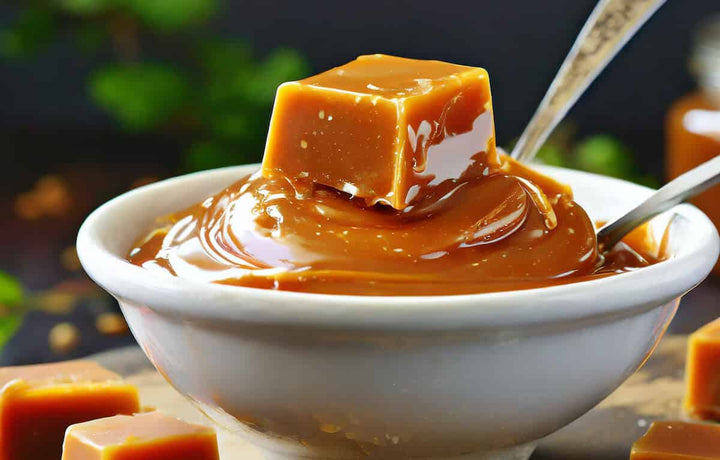Salted caramel, a culinary sensation that has taken the confectionery world by storm, is a perfect embodiment of how a simple twist can elevate a classic flavour to new heights.
This indulgent treat marries the rich, buttery sweetness of traditional caramel with a pinch of salt, creating an irresistible contrast that tantalises the taste buds.
In this post, we'll explore the origins and rise of salted caramel, a flavour that has become a favourite among chefs and sweet-toothed enthusiasts alike.
From its humble beginnings to its status as a gourmet staple, salted caramel's journey is as intriguing as its flavour profile.
Whether drizzled over desserts, infused into chocolates, or enjoyed as a standalone candy, salted caramel offers a delightful balance of sweet and savoury, making every bite a complex and satisfying culinary experience.
Join us as we delve into the world of salted caramel and discover why this unique combination continues to capture the imagination of food lovers around the globe.
What is Salted Caramel?
Salted caramel is a popular confectionery flavour that combines the rich, sweet taste of caramel with a hint of salt.
This addition of salt enhances the caramel's flavour and adds a delightful contrast to its inherent sweetness.
The basic ingredients of traditional caramel include sugar, which is heated and melted until it becomes golden and aromatic, along with butter and cream for a smooth, rich texture.
In salted caramel, fine salt – often sea salt or fleur de sel – is incorporated into the mixture, either during the cooking process or sprinkled on top as a finishing touch.
The result is a harmonious blend of flavours: the deep, buttery sweetness of the caramel is elevated by the subtle sharpness of the salt, creating a complex taste profile.
This combination balances the overall sweetness and brings out nuances in the caramel that might otherwise be overshadowed.
Salted caramel has gained immense popularity in recent years and has been incorporated into a wide range of desserts and confectioneries, such as chocolates, ice creams, sauces, and baked goods.
Its appeal lies in its ability to strike the perfect balance between sweet and savoury, making it a versatile and universally loved flavour.

What is the History of Salted Caramel?
The history of salted caramel, though relatively recent compared to many classic confections, is a fascinating tale of culinary innovation.
The roots of this now ubiquitous flavour combination can be traced back to France in the 1970s.
-
French Origins: The concept of salted caramel is widely credited to Henri Le Roux, a French chocolatier and patissier. In 1977, in the Brittany region known for its exceptional butter and sea salt, Le Roux sought to create a new confection. He developed a caramel with butter and sea salt, a blend that was revolutionary at the time. This caramel, known as 'Caramel au beurre salé', became immensely popular in France.
-
Brittany’s Influence: Brittany has a long-standing tradition of using salted butter, and it’s likely that salted caramels in some form have been part of the region's culinary heritage for a longer time. However, it was Le Roux's specific recipe and his promotion of the product that brought it to the limelight.
-
Global Popularity: From its origins in a small French region, salted caramel began to gain international attention in the 2000s. Chefs and food companies around the world started incorporating this flavour into a variety of products, from high-end chocolates and desserts to commercial ice creams and coffee beverages.
-
Modern-Day Staple: Today, salted caramel is considered a modern classic. Its perfect balance of sweet and savoury notes has made it a favourite flavour in numerous culinary creations. It's a testament to how a simple addition – a pinch of salt – can transform and elevate a traditional sweet into something extraordinary.
The story of salted caramel is a great example of culinary innovation and how a regional speciality can evolve into a global sensation cherished by food enthusiasts and confectioners alike.
What’s the Difference Between Salted and Normal Caramel?
The primary difference between salted caramel and normal (or unsalted) caramel lies in salt in the former, which significantly impacts both the flavour profile and the overall taste experience.
-
Flavour Contrast: Normal caramel is characterised by its sweet, buttery taste, derived from caramelised sugar combined with butter and cream. It has a rich, indulgent flavour profile that is predominantly sweet. In salted caramel, adding salt creates a contrast that enhances the complexity of the caramel’s flavour.
-
Taste Experience: Including salt in caramel adds a savoury element that appeals to those who enjoy a balance of sweet and savoury flavours. It elevates the taste experience by offering a more rounded and sophisticated flavour.
-
Culinary Applications: While salted and unsalted caramel can be used in various culinary contexts, salted caramel is often chosen for dishes where a contrast in flavours is desired. It’s particularly popular in desserts and confections where its unique sweet-savoury profile can shine, such as in chocolates, ice creams, and sauces.
Introducing salted caramel into the culinary world has provided chefs and food enthusiasts with an exciting alternative to traditional caramel, allowing for more creative and flavourful culinary creations.

What Does Salted Caramel Taste Like?
The primary flavour is the deep, buttery sweetness typical of caramel, made by cooking sugar until it achieves a golden-brown hue and develops a complex, slightly toasted taste.
This sweetness is typically enriched with cream or butter, giving it a luxurious, velvety texture.
However, the defining characteristic of salted caramel is the addition of salt – often sea salt or fleur de sel.
The salt does not overpower the sweetness but instead provides a delightful contrast.
It enhances the caramel’s flavour, cutting through the richness and bringing a unique depth to the overall taste.
This addition of salt also helps to balance the intense sweetness of the caramel, making it more palatable and intriguing to the taste buds.
The result is a harmonious blend of sweet and salty flavours with a creamy, sometimes gooey texture that melts in the mouth.
How to Make Salted Caramel at Home
Making salted caramel at home is a delightful and rewarding process.
It involves a few simple ingredients and careful attention to the cooking process.
Here’s a basic recipe to create delicious salted caramel:
Ingredients:
- 200g granulated sugar
- 90g unsalted butter, cut into pieces
- 120ml heavy cream (at room temperature)
- 1 tsp sea salt or to taste
Method:
-
Prepare Your Ingredients: Before you start, have all your ingredients measured and ready to go. This is important because the caramel-making process requires attention and speed.
-
Melt the Sugar: In a medium, heavy-bottomed saucepan, heat the sugar over medium heat, stirring constantly with a heat-resistant spatula or wooden spoon. The sugar forms clumps and eventually melts into a thick, amber-coloured liquid. Ensure it doesn't burn.
-
Add the Butter: Once the sugar has completely melted, add the butter. Be careful, as the caramel will bubble rapidly when the butter is added. Stir the butter into the caramel until it is completely melted, about 2-3 minutes.
-
Slowly Add the Cream: Very slowly, drizzle in the heavy cream while stirring. Since the cream is colder than the caramel, the mixture will rapidly bubble and/or splatter when added. Allow the mixture to boil for a minute. It will rise in the pan as it boils.
-
Remove from Heat and Add Salt: Remove the pan from the heat and stir in the salt. Start with a half teaspoon and adjust to your taste.
-
Cool Down: Allow the salted caramel to cool down before using. It will thicken as it cools.
-
Store: You can store the salted caramel in a jar or container in the refrigerator for up to two weeks. Warm it up slightly before using it in recipes.
Safety Tips:
- Be careful when handling the caramel, as it is extremely hot and can cause severe burns.
- Use a larger pot than you think you’ll need, as caramel bubbles up when butter and cream are added.
The key to success is patience and not rushing the caramelisation process.
Where Can You Buy Tasty Chocolate?
Whitakers Chocolates, renowned for our long history in crafting delicious and affordable chocolates, offers a range of options suitable for everyone, including vegetarian, vegan, and gluten-free choices.
Our top-selling products, such as indulgent Coffee Creams, Neapolitans, Chocolate Wafer Thins, Stem Ginger and Luxury Chocolate Truffles, are perfect for enhancing your mocha coffee experience.
Click here to see our delicious range of chocolate...
Some Notes From an Expert Chocolatier
As an expert chocolatier, I've found that incorporating salted caramel into chocolate products adds an exquisite layer of complexity and taste.
When contrasted with the subtle sharpness of the salt, the rich, buttery sweetness of the caramel creates an enchanting flavour profile that enhances the depth of the chocolate.
In my creations, I particularly enjoy the interplay of salted caramel with different types of chocolate.
Pairing it with dark chocolate, for instance, balances the cocoa's bitterness with the caramel's sweetness while combining it with milk chocolate creates a harmonious blend of sweetness and creaminess.
The salt in the caramel accentuates the caramel's flavour and brings out the nuanced notes of the chocolate, making each bite a multi-layered sensory experience.
Experimenting with the consistency of the caramel allows for a range of textures in our chocolate products, from soft, gooey fillings to a slightly firmer, chewy layer.
Final Notes On Salted Caramel
Salted caramel is a remarkable culinary creation, a testament to the power of simple innovation in transforming traditional flavours.
Its inception, rooted in the combination of sweet and salty, has led to a flavour sensation that has captivated palates worldwide.
The allure of salted caramel lies in its perfect balance – the rich, indulgent sweetness of caramel offset by the subtle sharpness of salt, creating a complex and sophisticated taste experience.
This delightful fusion has found its way into various confections, from luxurious chocolates and creamy ice creams to gourmet desserts and artisanal pastries.











